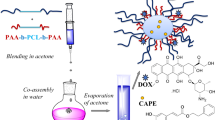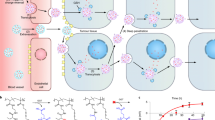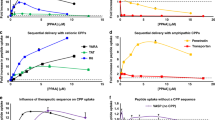Abstract
During recent years N-(2-hydroxypropyl)methacrylamide (HPMA) copolymers have been developed as targetable drug carriers. These soluble synthetic polymers are internalized by cells by pinocytosis and they can be tailor-made to include peptidyl side-chains degradable intracellularly by specific lysosomal enzymes. Thus they provide the opportunity fo achieve controlled intracellular delivery of anticancer agents. The anthracycline antibiotic daunomycin, and protein synthesis inhibitor puromycin, were bound to HPMA copolymers via several different peptide side-chains, including Gly-Gly, Gly-Phe-Leu-Gly and Gly-Phe-Phe-Leu. Incubation of polymer-drug conjugates with isolated lysosomal enzymes (either a mixture of rat liver lysosomal enzymes or purified thiol-dependent lysosomal proteinases, cathepsins L and B) showed that significant release of drug occurred over 20 h, more than 20% of daunomycin and more than 80% of puromycin being liberated. To test their pharmacological activity conjugates were incubated with either the mouse leukaemia L1210, or the human lymphoblastoid leukaemia CCRF in vitro. The conjugates tested were all less effective than free daunomycin, but they showed differential toxicity against L1210 depending on the aminoacid sequence of their drug-polymer linkage. Inclusion of fucosylamine-terminating side-chains into the HPMA copolymer structure increased the affinity of conjugates for the L1210 cell membrane and resulted in increased toxicity. In contrast HPMA-daunomycin conjugates with or without fucosylamine affected CCRF cells equally, but this cell line was more sensitive than the mouse leukaemia to both free and polymer-bound daunomycin. Incubation of L1210 cells in polymer-bound daunomycin for 72 h, followed by plating cells out in low density in drug-free medium, showed that a concentration of polymer-bound drug (184 micrograms ml-1) could be selected to achieve a cytotoxic effect.
This is a preview of subscription content, access via your institution
Access options
Subscribe to this journal
Receive 24 print issues and online access
$259.00 per year
only $10.79 per issue
Buy this article
- Purchase on Springer Link
- Instant access to full article PDF
Prices may be subject to local taxes which are calculated during checkout
Similar content being viewed by others
Rights and permissions
About this article
Cite this article
Duncan, R., Kopečková-Rejmanová, P., Strohalm, J. et al. Anticancer agents coupled to N-(2-hydroxypropyl)methacrylamide copolymers. I. Evaluation of daunomycin and puromycin conjugates in vitro. Br J Cancer 55, 165–174 (1987). https://doi.org/10.1038/bjc.1987.33
Issue Date:
DOI: https://doi.org/10.1038/bjc.1987.33
This article is cited by
-
Cathepsin B-responsive prodrugs for cancer-targeted therapy: Recent advances and progress for clinical translation
Nano Research (2022)
-
Stability evaluation of Gd chelates for macromolecular MRI contrast agents
Magnetic Resonance Materials in Physics, Biology and Medicine (2020)
-
Particle toxicology and health - where are we?
Particle and Fibre Toxicology (2019)
-
Nanomedicines for Malaria Chemotherapy: Encapsulation vs. Polymer Therapeutics
Pharmaceutical Research (2018)
-
Radiolabeling and cell incorporation studies of gemcitabine HCl microspheres on bladder cancer and papilloma cell line
Journal of Radioanalytical and Nuclear Chemistry (2016)



